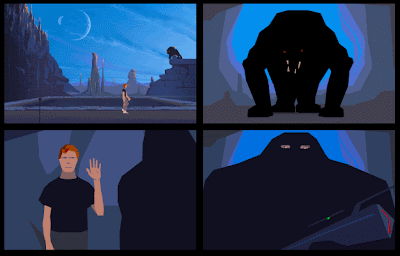Sorry Jones, but you don't understand the nature of videogames [resposta a]
A curadora do MoMA Paola Antonelli, italiana e defensora do Design como Arte (ver Ted Talk), diz-nos que o trabalho de selecção foi feito conjuntamente com o especialista em design de algoritmos Kevin Slavin (ver Ted Talk), Chris Romero que fez recentemente a sua tese de mestrado sobre videojogos e museus, e os críticos da Kill Screen Jamin Warren e Ryan Kuo. Em termos mais gerais explica o que está por detrás do trabalho de curadoria e do interesse do MoMA nos videojogos,
"curators seek a combination of historical and cultural relevance, aesthetic expression, functional and structural soundness, innovative approaches to technology and behavior, and a successful synthesis of materials and techniques in achieving the goal set by the initial program. This is as true for a stool or a helicopter as it is for an interface or a video game, in which the programming language takes the place of the wood or plastics, and the quality of the interaction translates in the digital world what the synthesis of form and function represent in the physical one."
flOw (2006) de Jenova Chen
Paola Antonelli refere que os parâmetros utilizados na selecção foram quatro - comportamento, estética, espaço e tempo.
Behavior
"scenarios, rules, stimuli, incentives, and narratives envisioned by the designers come alive in the behaviors they encourage and elicit from the players"
Aesthetics
"Just like in the real world, particularly inventive and innovative designers have excelled at using technology’s limitations to enhance a game’s identity"
Space
"an architecture that is planned, designed, and constructed according to a precise program, sometimes pushing technology to its limits in order to create brand new degrees of expressive and spatial freedom"
Time
"Interaction design is quintessentially dynamic, and the way in which the dimension of time is expressed and incorporated into the game is a crucial design choice."
Tetris (1984) de Alexey Pajitnov (versão arcade)
"The worlds created by electronic games are more like playgrounds where experience is created by the interaction between a player and a programme. The player cannot claim to impose a personal vision of life on the game, while the creator of the game has ceded that responsibility. No one "owns" the game, so there is no artist, and therefore no work of art."
Passage (2007) de Jason Rohrer
"Não existe artista" porque "a experiência é criada entre o jogador e um programa"! Mas como é que isso difere da experiência criada entre um livro e um leitor, entre um quadro e um espectador? Toda a arte requer interacção cognitiva por parte do seu receptor. Aliás fenomenologicamente falando, não existe arte sem receptor.
Katamari Damacy (2004) de Keita Takahashi
Jones refere-se aqui à interactividade mas esta é apenas aquilo que torna a arte dos videojogos singular, tal como a montagem torna o cinema singular. Mas a interactividade não se cria no vazio, não surge do nada, é antes fruto do comportamento, estética, espaço e tempo criados por um autor. É todo um trabalho de uma enorme mestria no desenho de cada experiência de interacção de um jogo. E não, não é uma mestria estagnada na forma, é uma mestria em permanente evolução, em busca da originalidade, tentando quebrar convenções e cânones, em busca da criação de formas experienciais nunca antes percepcionadas. E isto não é arte?
Another World (1991) de Eric Chahi
Myst (1993) de Robyn Miller e Rand Miller
Quando Jones diz "look at those masterpieces it holds by Picasso and Jackson Pollock, and what you are seeing is a series of personal visions". Sim, visões pessoais, tal como Katamari Damacy ou Portal, para não falar em Another World ou Myst. E porque não Pac-Man ou Tetris, porque uma obra de arte não vale por si apenas, vale também pelo contexto e momento da história em que aparece, vale pelo que tem a dizer sobre o meio em que se expressa, pelo modo como vai além do até aí imaginado pela genialidade da mente humana.
Portal (2007) da Valve








The MOMA has done the right thing. After NEOLUDICA ART IS A GAME at Biennale Venice 2011 it was recognized that the world is a video game, a total bet on our future, in which video game as a medium, knowingly sprung from its own fiction, may finally get out of the mirror, like Alice, in order to express its thought on a society that has never been so stratified and complex. The two realities – which sum up to form one augmented reality – are very much alike and cannot do without one another. Artists, creators, developers and players are then called upon to step up in class, andto accept a confrontation that will be aesthetic as well as ethic, and therefore will bring upmore daydreams.Today more than ever we are moved by Lewis Mumford’s words from his 1934 essayTechnics and Civilization: “Thanks to machines, we now have a chance to understand a worldwe contributed to create.”In Italy the videogame is art and is exhibited in museums:
ResponderEliminarhttp://www.museoscienza.org/english/activities/assassins-creed/
http://neoludica.blogspot.it/2011/02/archetypes-and-landscapes-post.html
http://www.prlog.org/11733478-neoludica-art-is-game-2011-1966-art-meets-videogames.html
Hi
ResponderEliminarThanks for your comment and the very interesting links.
If you publish anywhere online, twitter/facebook let me know to follow.
best
Thanks, Nelson, I'll do it. In any case, I follow on neoludica.blogspot.it: there will be important news.
ResponderEliminarHave a good day.